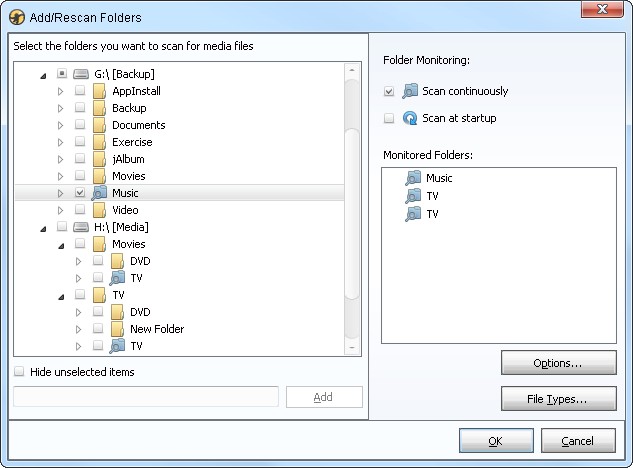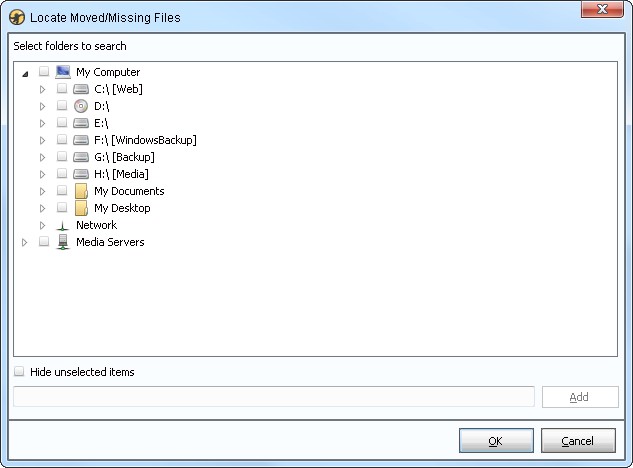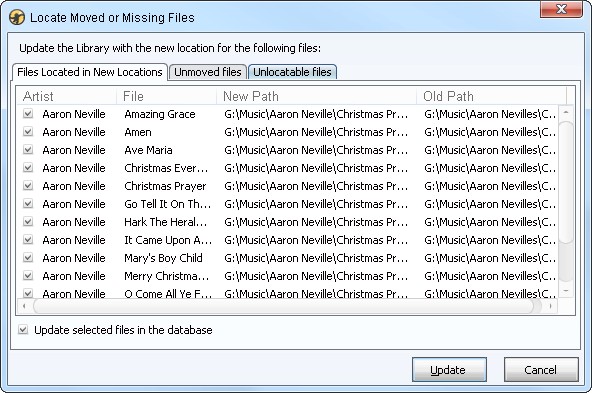Agregar archivos existentes al Catálogo
Help > Getting Started > Agregar archivos existentes al Catálogo
Agregar archivos Multimedia al catálogo le permitirá crear Listas de Reproducción y AutoListas de Reproducción así como realizar un seguimiento del número de reproducciones. Usted puece acceder a los archivos Multimedia no en el catálogo a través del nodo Mi Ordenador, pero las reproducciones no serán recordadas por este nodo.
Búsqueda manual de Archivos en el Catálogo
Para gestionar sus archivos Multimedia deberá agregarlos al Catálogo. Esto se realiza automáticamente la primera vez que ejecuta la aplicación. Subsecuentemente usted podrá realizar este proceso manualmente:
- Seleccione Archivos > Añadir/Reexaminar archivos al Catálogo en el menú principal, o presione <Insertar>.
- Elija la qué Unidad, Carpeta o Ubicación de Red que desee agregar.
- Si usted desea introducir una ruta de red, teclee la ruta que desea escanear entre comillas y use el botón Agregar.
- Utilice el botón Tipos de Archivo para seleccionar qué Archivos Multimedia agregará a su Catálogo.
- Use el botón Opciones para cambiar las opciones que afectan la examinación de archivos.
- Habilite Ocultar items no seleccionados para mostrar solamente carpetas seleccionadas para ser examinadas.
- Cuando los archivos son añadidos por primera vez al Catálogo de MediaMonkey automaticamente ajustará el tipo y colocará el archivo en la Colección respectiva como Música, Clásica, Música o Videos. Todos los archivos serán visibles en el catálogo completo de la Colección.

Además puede definir otras opciones como qué tipos de archivos a analizarse. Una vez que pulse el botón 'Aceptar', MediaMonkey explorará las ubicaciones seleccionadas para los tipos de Archivos Multimedia que ha elegido, y:
- Agregará cualquier Archivo Multimedia nuevo y asociará el Arte (de archivos o etiquetas) al Catálogo.
- Catalogará el contenido de cualquier CD que sea encontrado en el Catálogo. Los CD que hayan sido agregados al Catálogo aparecerán en el modo Ubicación de la Colección. Si cualquier CD es seleccionado para ser examinado, los archivos en el CD aparecerán en color gris si el CD no está insertado y de color negro si el CD está insertado.
- Agregará cualquier Lista de Reproducción .m3u que encuentre en el Catálogo, junto con cualquiera de los Archivos Multimedia contenidos en la Lista de Reproducción (si han sido encontrados en la ruta almacenada del archivo M3U).
- Notificará sobre cualquiera de los Archivos Multimedia que faltan en la ubicación examinada y le dará la opción de removerlos del Catálogo o encontrarlos utilizando Locate Moved/Missing files.

The Remove Unavailable Files dialog window
- Actualizará las propiedades de cualquier archivo multimedia que haya cambiado (configuración, por defecto, solo pistas que cuyo tamaño de archivo o marcas de tiempo hayan cambiado serán actualizados).
- Le brindará la opción de importar estadísticas perdidas, número de reproducciones y las últimas pistas reproducidas asociadas con archivos multimedia desde Windows Media Player, iTunes o Winamp si alguno de ellos reside en su computadora.

The Import Data dialog window
Uso del Monitoreo de Carpetas para Automáticamente Actualizar el Catálogo
El cuadro de diálogo de Agregar/Reexaminar archivos al Catálogo le permitirá monitorear las carpetas seleccionadas para que los cambios realizados a Archivos Multimedia sean actualizados automáticamente en el Catálogo. To do so select a folder in the left hand side and under and under Folder Monitoring you can:
- Seleccione Examinar continuamente en cualquier Carpeta para actualizar el Catálogo si ocurren cambios mientras MediaMonkey se encuentra ejecutándose.
- Seleccione Examinar al iniciar para cualquier Carpeta para verificar los cambios y actualizar el Catálogo con los cambios que ocurrieron mientras MediaMonkey estaba en ejecución.
En adición, al actualizar el catálogo por agregar/cambiar Archivos Multimedia se realizarán las siguientes acciones:
- Automáticamente removerá cualquier Archivo Multimedia que haya sido eliminado (habilite/deshabilite la opción Herramientas > Opciones > Catálogo del menú principal con la opción Eliminar items no disponibles.)
- Automáticamente cambiará la ubicación de los Archivos Multimedia que hayan sido movidos.
Si está planeando mover archivos fuera de MediaMonkey ya sea manualmente en el Explorador de Windows o utilizando otra aplicación deberá habilitar la opción Examinar continuamente en ambos tanto la carpeta fuente como la carpeta destino y salga de MediaMonkey mientras realiza los cambios. Esta es la forma en la que el Catálogo de MediaMonkey permanecerá a la fecha con las nuevas ubicaciones de archivo. Sin embarto, deberá comprobar en crear métodos para mover archivos ya que existen otras herramientas para hacer usar este método.
Agregar Manualmente Archivos Multimedia Individuales
Puede agregar manaualmente Archivos Multimedia individuales al Catálogo sin tener que examinar carpetas mediante lo siguiente:
- Arrastre & suelte los archivos en los nodos principales de Colección en el Árbol Multimedia de MediaMonkey.
You can manually add individual Media Files to the Library without having to rescan folders by:
- Dragging & dropping them on the main Collection nodes in the MediaMonkey Media Tree from Windows Explorer.
- Dragging & dropping them into the Now Playing and from the Now Playing dragging & dropping them onto a Playlist (not AutoPlaylists.)
Manually Locate Moved/Missing Files
If Media Files have been moved by another application to a new location, MediaMonkey will automatically find the Media File when the File Monitor is configured to monitor the directory to which the media file has been moved. For other cases:
- Go to Collection > Files to Edit > Dead Links in the MediaMonkey Media Tree. You will see a list of Media Files that are inaccessible because they have either been moved or deleted.
- Select the Media File(s) you want to find, and select File > Locate Moved/Missing files on the main menu.
- Choose which drives you would like to scan for the Media File(s).

Locate Moved/Missing files dialog - A dialog will appear showing moved files that have been found, files that haven't been moved, and files that couldn't be found. Of those that have been found, select the check box next to them to confirm that you want to update the library with the location indicated.
- The Files Located in New Locations tab shows all files that were moved and have been found in a new location by Locate Moved/Missing Files. Enable Update selected files in the database if you want to update the paths on selected files in the database with the new locations found.
- The Unmoved files tab shows all files that are still accessible in the location stored in the Library.
- The Unlocatable files tab shows all files that were moved, but can't be found by MediaMonkey in the scanned locations. Enable Remove selected files from the database if you want to remove the selected files that couldn't be located from your Library.

Notes
- If you wish to interrupt the file scanning process at any time, simply right-click on the status bar near the bottom of the screen, and click Terminate. If you wish to reduce the amount of CPU cycles used during the process, you may similarly right-click on the status bar, select Change Priority, and choose a lower priority level.
- Although the File Monitor does monitor for moved files, it only searches the specified directories for the moved file, and consequently will not detect the location of the moved file if it has been moved to an unmonitored directory. For these situations, you can use Locate Moved/Missing files.
- Locate Moved/Missing Files finds files based on Filesize and Timestamps or track metadata (Length, Artist, Album and Title).
- If you have Media Files located on drives A or B you'll need to remove the used drive letter(s) from IgnoreDriveLetters=AB in the MediaMonkey.ini[1] file (make sure MediaMonkey is closed when editing MediaMonkey.ini[2].)
- If you have music stored in network locations it is preferred that you use the UNC Path (\\PCName\MusicFolder) instead of using Mapped Drives.
- Did not import xx files (did not match import criteria) will show a count of all files found in the scanned folder not matching the enabled File Types. This includes non Media Files like Office documents and application files, but also all Media Files not enabled under File Types.
- The File Types setting in the Add/Rescan files to the Library dialog selects which types of files should be added to the Library. The File Types under Tools > Options > OS Integration selects for which File Types MediaMonkey will be set as default program to open them with.
- Only dragging & dropping on the main Collection nodes will add files to the Library. This is because other nodes like Album are meant to tag the file and thus MediaMonkey protects against inadvertent tagging by disabling drag & drop from outside of MediaMonkey on those nodes.
- Files located on drives no longer connected will not be listed in the Dead Links node.
- Art stored as files is only added on scanning when only Media Files belonging to the same Album/Series are stored in the folder with the Art and the option to Scan file directories for Artwork is enabled under Tools > Options > Library.
- To add Media Files from UPnP Media Servers select the Media Server in the MediaMonkey Media Tree and select File > Add/Rescan files to the Library on the main menu, or press <Insert>.
- To re-enable the Import Data dialog after scanning set ConfirmImportRatings to ConfirmImportRatings=1 in the MediaMonkey.ini[3] file (make sure MediaMonkey is closed when editing MediaMonkey.ini[4].)
- To re-enable the Scan Results dialog after scanning set ConfirmScanResults to ConfirmScanResults=1 in the MediaMonkey.ini[5] file (make sure MediaMonkey is closed when editing MediaMonkey.ini[6].)
- An Locate Moved/Missing Files alternative is the Update Location of Files in Database addon [7] or the DriveID addon [8].
Related Information
Ripping Tracks from CDs
Ripping Tracks and Cataloguing CDs
Adding CDs to the Library
Next: Browse the Library
| English • Deutsch • español • français |
Additional Help: Knowledge Base | Forum | MediaMonkey Support | MediaMonkey for Android Help | MediaMonkey 5 Help | MediaMonkey 4 Help
